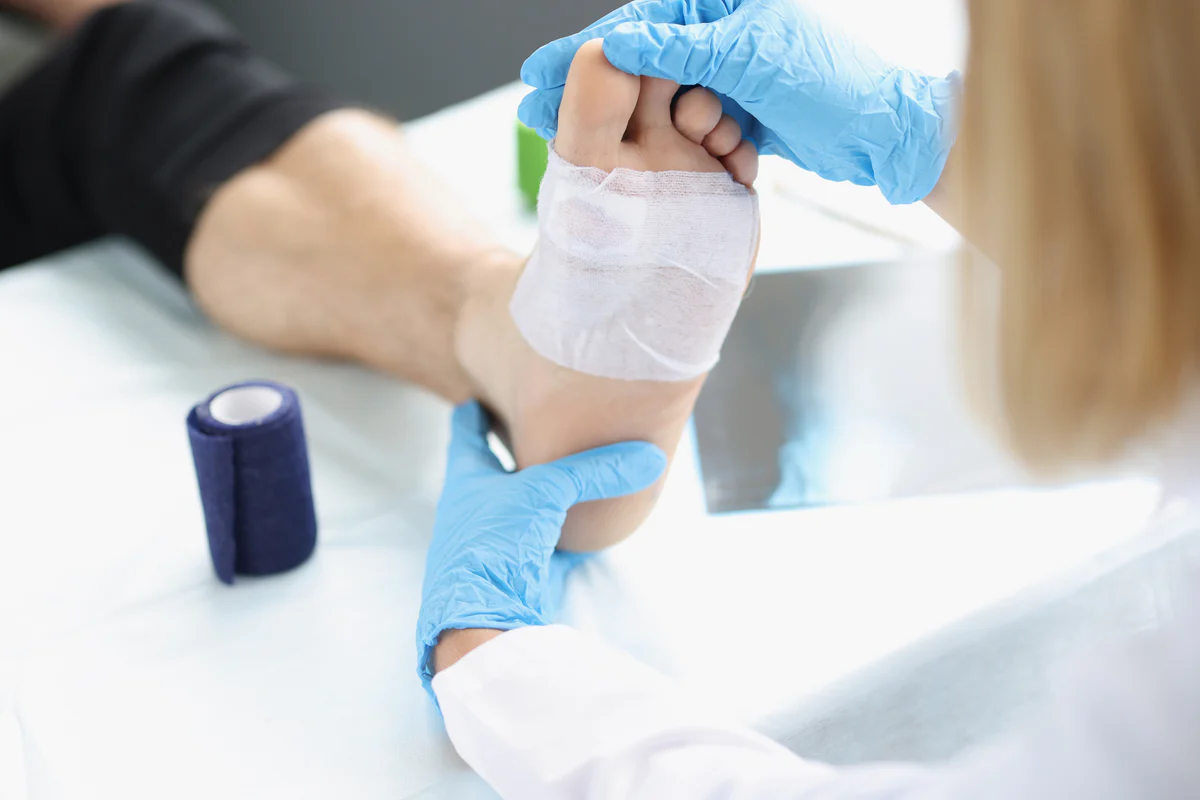Understanding Forefoot Ulcers
Forefoot ulcers are open wounds that commonly appear on the ball of the foot or toes, areas constantly exposed to pressure during walking or standing. They are particularly concerning because they can worsen quickly without proper care, especially for individuals living with chronic conditions such as diabetes. These ulcers often develop due to repeated stress, friction, or poor circulation in the lower extremities. Early signs may include redness, swelling, drainage, or tenderness around the affected area. If untreated, these wounds can deepen and create serious complications, such as infections that may spread to surrounding tissues or bones. Because the forefoot carries significant weight with each step, even small sores may escalate into large ulcers. Understanding how they form and progress highlights the need for targeted medical care, particularly through orthopedic expertise.
Why Orthopedic Treatment Plays a Critical Role
Orthopedic treatment for forefoot ulcers is essential because it addresses the underlying mechanical and structural factors that contribute to their development. Unlike general wound care, which often focuses only on cleaning and dressing the wound, orthopedic specialists analyze how pressure points and gait issues affect healing. They approach care with both immediate wound management and long-term prevention in mind. This dual focus is particularly beneficial for patients with recurrent ulcers, as orthopedic intervention helps reduce the risk of repeat injuries. Orthopedic care also emphasizes maintaining mobility, so patients can continue walking safely without aggravating the wound. Furthermore, orthopedic treatment is tailored to individual needs, ensuring the root causes of ulcer formation, such as misaligned joints or poor footwear, are directly addressed. This specialized approach not only promotes faster healing but also reduces the risk of complications like infections or amputations.
Common Causes of Forefoot Ulcers
Several factors contribute to the formation of forefoot ulcers, and many are directly linked to lifestyle, footwear, and medical conditions. One of the most common causes is excessive pressure on the forefoot due to ill-fitting shoes that compress the toes or fail to provide adequate cushioning. People with diabetes are particularly vulnerable, as nerve damage from diabetic neuropathy can prevent them from feeling pain or noticing small injuries that progress into ulcers. Poor circulation from peripheral artery disease further complicates healing by reducing blood supply to the affected area. Repetitive stress, such as walking long distances or standing for extended periods without proper footwear, also increases the likelihood of ulcer development. Structural deformities like bunions, hammertoes, or high arches create additional points of pressure that break down skin and tissue. Even lifestyle habits, such as smoking, can restrict blood flow and slow down the healing process. Identifying these causes is the first step toward effective orthopedic management.
Diagnostic Approaches in Orthopedic Care
When patients present with forefoot ulcers, orthopedic specialists use a variety of diagnostic methods to assess the condition and its underlying causes. A thorough physical examination is the first step, during which the wound is inspected for size, depth, and signs of infection. Imaging tests such as X-rays or MRIs may be performed to check whether the ulcer has reached the bone or if there are structural abnormalities affecting the forefoot. Pressure mapping and gait analysis are advanced diagnostic tools that evaluate how weight is distributed across the foot during movement. These tests often reveal hidden biomechanical stress points that contribute to repeated ulceration. Blood flow studies may also be recommended to measure circulation in the lower limbs, especially in patients with vascular disease. By combining surface-level wound assessments with internal imaging and functional tests, orthopedic specialists create a comprehensive picture of the problem. This holistic diagnostic process ensures that treatment plans are both accurate and personalized.
Orthopedic Treatment Options for Forefoot Ulcers
Orthopedic treatment for forefoot ulcers involves a range of strategies tailored to the severity of the wound and the patient’s overall health. Wound debridement is often performed to remove dead or infected tissue, allowing healthy skin to regenerate more effectively. Specialized dressings and topical medications are then applied to protect the ulcer and promote healing. One of the most critical orthopedic techniques is offloading, which reduces pressure on the affected area through devices such as total contact casts, orthotic insoles, or custom footwear. In cases where ulcers fail to heal with conservative measures, surgical options may be considered, including correction of deformities or procedures to improve circulation. Advanced therapies, such as skin grafts or the use of biologics and growth factors, can also accelerate the healing process in severe or chronic cases. Each treatment is carefully selected based on the ulcer’s depth, infection risk, and the patient’s mobility needs. The goal of orthopedic treatment is not only to heal the wound but also to prevent recurrence by addressing its root causes.
Preventive Orthopedic Strategies
Prevention is a cornerstone of orthopedic care for patients at risk of forefoot ulcers. Choosing proper footwear is one of the most effective preventive strategies, as well-fitted shoes with adequate cushioning and support reduce harmful pressure points. Orthopedic specialists may prescribe custom orthotics to evenly distribute weight across the foot and protect vulnerable areas from repetitive stress. Regular check-ups with podiatrists and orthopedic doctors help identify early warning signs before they progress into serious ulcers. Lifestyle adjustments such as weight management and targeted physical therapy also reduce strain on the forefoot and promote better mobility. Daily foot care routines, including inspection for small cuts, moisturizing to prevent dryness, and prompt cleaning of minor wounds, are especially important for individuals with diabetes. Patients are also encouraged to avoid walking barefoot, as it increases the risk of injuries that may go unnoticed. By adopting these preventive measures, patients significantly lower their chances of developing new ulcers.
The Impact of Early Orthopedic Intervention
Timely orthopedic treatment for forefoot ulcers can make the difference between a manageable wound and a life-threatening complication. Early intervention prevents infections from spreading and dramatically reduces the risk of amputation. Studies show that patients who receive prompt orthopedic care experience faster recovery times and fewer recurrences compared to those who delay treatment. Orthopedic specialists focus on restoring mobility while ensuring the wound remains protected, helping patients maintain independence and daily activities. When treatment is delayed, ulcers may penetrate deeper into tissues and bones, requiring more invasive procedures that could have been avoided with earlier care. Patient compliance also plays a major role in successful outcomes, as following medical advice on footwear, offloading, and wound care ensures consistent healing. Ultimately, early orthopedic intervention safeguards both physical health and quality of life, giving patients the best possible chance for recovery.
Living with a History of Forefoot Ulcers
For individuals who have previously experienced forefoot ulcers, ongoing orthopedic care is essential to prevent recurrence. Lifestyle modifications are often necessary, such as choosing activity levels that do not overstrain the forefoot while still promoting circulation and overall fitness. Proper footwear remains a lifelong commitment, with many patients relying on custom orthotics or therapeutic shoes for continued protection. Emotional well-being should also be considered, as living with chronic wounds or mobility challenges can lead to stress or anxiety. Support groups, counseling, or rehabilitation programs can provide encouragement and coping strategies. Patients are encouraged to remain proactive in their foot care routines, regularly inspecting for any new signs of skin breakdown or discomfort. Routine follow-ups with orthopedic and podiatric specialists provide an added layer of protection by addressing minor issues before they escalate. By integrating medical guidance with self-care and support, patients with a history of forefoot ulcers can lead active, fulfilling lives.
FAQ
What makes orthopedic treatment different from standard wound care?
Orthopedic treatment for forefoot ulcers goes beyond cleaning and dressing wounds by addressing the root biomechanical causes of ulceration. Specialists assess gait, pressure points, and structural deformities to create customized treatment plans that promote healing and prevent recurrence.
How long does it typically take for a forefoot ulcer to heal with orthopedic care?
Healing times vary depending on the severity of the ulcer and patient compliance with treatment. Minor ulcers may heal within weeks, while more complex wounds can take several months, especially if underlying conditions like diabetes are present.
Can custom orthotics completely prevent forefoot ulcers?
Custom orthotics significantly reduce the risk by redistributing pressure and protecting vulnerable areas, but they cannot guarantee complete prevention. Regular monitoring and proper foot hygiene remain essential.
When should someone seek urgent orthopedic help for a foot ulcer?
Any open wound on the forefoot that shows signs of infection, such as redness, swelling, pus, or worsening pain, should be evaluated by an orthopedic specialist immediately. Delaying care increases the risk of severe complications.
Are surgical procedures always necessary for severe ulcers?
Not all severe ulcers require surgery, but surgical options may be considered when conservative treatments fail. These procedures aim to correct deformities, improve circulation, or cover the wound with grafts to promote healing.
What are the risks of ignoring or delaying treatment for a forefoot ulcer?
Ignoring a forefoot ulcer can result in infections that spread to deeper tissues or bones, potentially leading to gangrene or amputation. Early orthopedic intervention is crucial to avoid these life-threatening complications.






